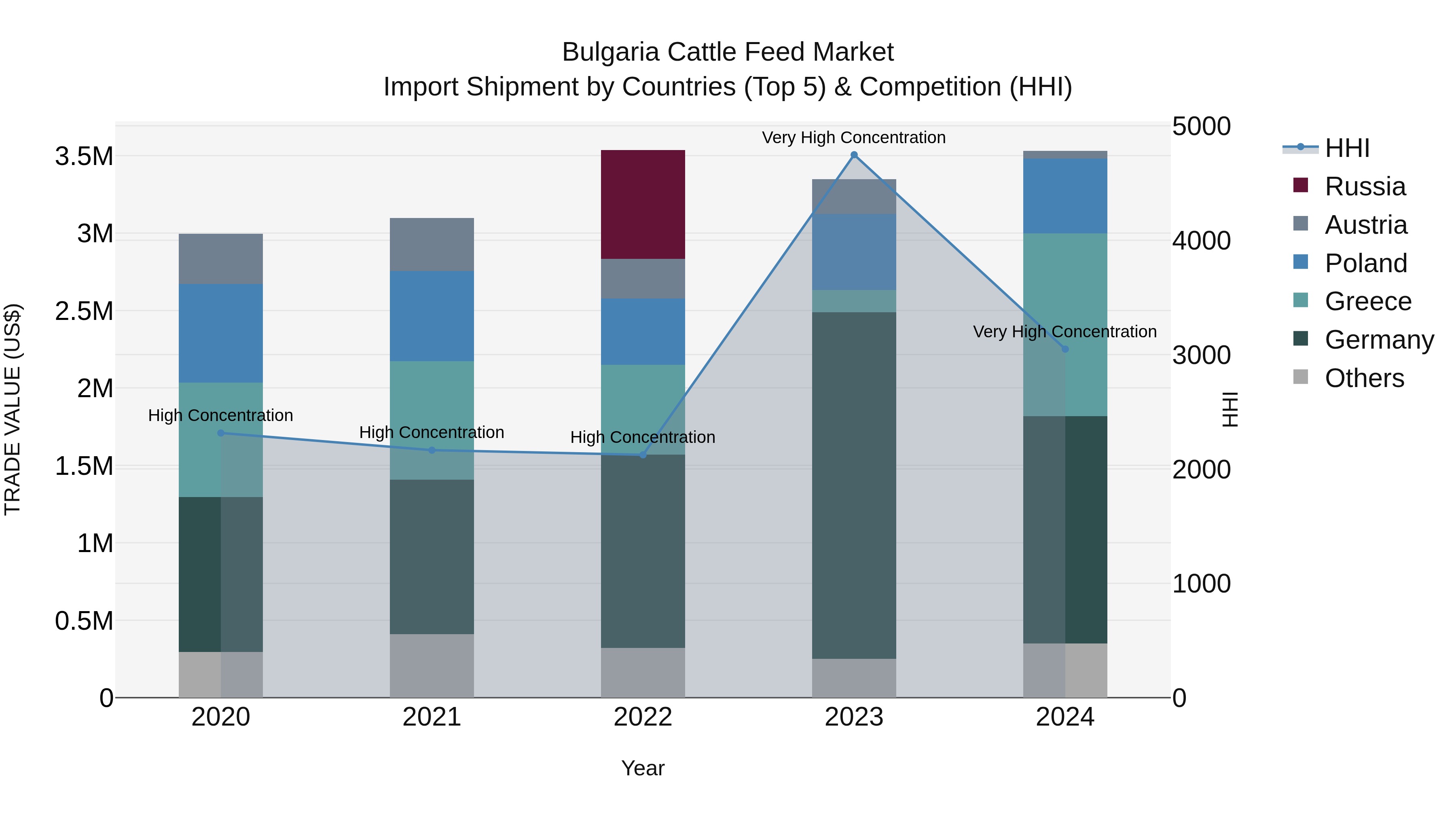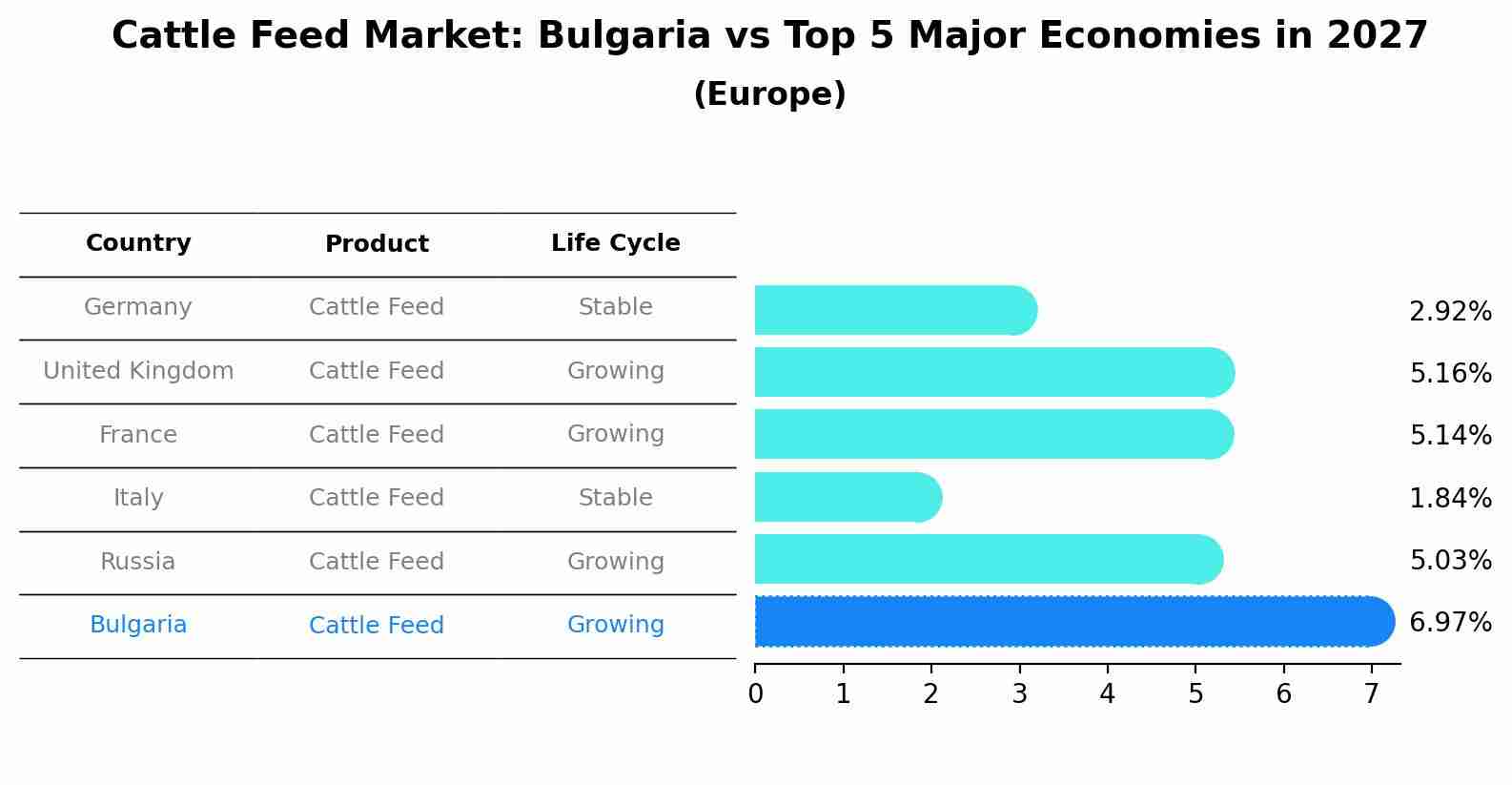Bulgaria Cattle Feed Market (2025-2031) | Revenue, Industry, Companies, Growth, Analysis, Value, Size, Forecast, Segmentation, Outlook, Share & Trends
| Product Code: ETC4983920 | Publication Date: Nov 2023 | Updated Date: Oct 2025 | Product Type: Market Research Report | |
| Publisher: 6Wresearch | Author: Sachin Kumar Rai | No. of Pages: 60 | No. of Figures: 30 | No. of Tables: 5 |
Bulgaria Cattle Feed Market Top 5 Importing Countries and Market Competition (HHI) Analysis
Bulgaria`s cattle feed import Market Top 5 Importing Countries and Market Competition (HHI) Analysis in 2024 continued to be dominated by key suppliers such as Germany, Greece, Poland, Metropolitan France, and Croatia. The Herfindahl-Hirschman Index (HHI) indicated a high level of Market Top 5 Importing Countries and Market Competition (HHI) Analysis concentration, suggesting limited competition. The industry demonstrated steady growth with a Compound Annual Growth Rate (CAGR) of 4.2% from 2020 to 2024. Moreover, the growth rate in 2024 accelerated to 5.43%, indicating a positive trend for cattle feed imports in Bulgaria. This data underscores the significance of these countries in supplying cattle feed to meet Bulgaria`s Market Top 5 Importing Countries and Market Competition (HHI) Analysis demands.

Cattle Feed Market: Bulgaria vs Top 5 Major Economies in 2027 (Europe)
Bulgaria's Cattle Feed market is anticipated to experience a growing growth rate of 6.97% by 2027, reflecting trends observed in the largest economy Germany, followed by United Kingdom, France, Italy and Russia.

Bulgaria Cattle Feed Market Overview
The cattle feed market in Bulgaria is influenced by the agricultural sector, particularly livestock farming. Cattle feed includes various nutritional supplements and feed additives designed to improve the health and productivity of cattle. The market is driven by the demand for high-quality feed that supports optimal growth and milk production. Trends towards more sustainable and efficient feed solutions are also shaping the market.
Drivers of the market
The cattle feed market in Bulgaria is influenced by the need to support livestock health and productivity. High-quality cattle feed is essential for providing proper nutrition and enhancing meat and milk production. The growth in the livestock industry and the focus on improving animal health and productivity drive the demand for cattle feed.
Challenges of the market
The Bulgaria Cattle Feed Market faces challenges related to fluctuations in raw material prices, particularly for grains and oilseeds, which can impact pricing and profitability. Additionally, the market is impacted by changing consumer preferences, with increasing demand for organic and non-GMO cattle feed products. The market also requires continuous innovation to meet the evolving demands of the livestock industry, particularly in terms of nutritional content and sustainability.
Government Policy of the market
Regulations for the cattle feed market in Bulgaria focus on ensuring the safety and nutritional quality of feed products. The government sets standards for the ingredients, processing, and labeling of cattle feed to ensure that it supports animal health and meets regulatory requirements.
Key Highlights of the Report:
- Bulgaria Cattle Feed Market Outlook
- Market Size of Bulgaria Cattle Feed Market, 2024
- Forecast of Bulgaria Cattle Feed Market, 2031
- Historical Data and Forecast of Bulgaria Cattle Feed Revenues & Volume for the Period 2021-2031
- Bulgaria Cattle Feed Market Trend Evolution
- Bulgaria Cattle Feed Market Drivers and Challenges
- Bulgaria Cattle Feed Price Trends
- Bulgaria Cattle Feed Porter`s Five Forces
- Bulgaria Cattle Feed Industry Life Cycle
- Historical Data and Forecast of Bulgaria Cattle Feed Market Revenues & Volume By Source for the Period 2021-2031
- Historical Data and Forecast of Bulgaria Cattle Feed Market Revenues & Volume By Organic for the Period 2021-2031
- Historical Data and Forecast of Bulgaria Cattle Feed Market Revenues & Volume By Conventional for the Period 2021-2031
- Historical Data and Forecast of Bulgaria Cattle Feed Market Revenues & Volume By Application for the Period 2021-2031
- Historical Data and Forecast of Bulgaria Cattle Feed Market Revenues & Volume By Agriculture for the Period 2021-2031
- Historical Data and Forecast of Bulgaria Cattle Feed Market Revenues & Volume By Industrial for the Period 2021-2031
- Historical Data and Forecast of Bulgaria Cattle Feed Market Revenues & Volume By Sales Channel for the Period 2021-2031
- Historical Data and Forecast of Bulgaria Cattle Feed Market Revenues & Volume By Direct Sales for the Period 2021-2031
- Historical Data and Forecast of Bulgaria Cattle Feed Market Revenues & Volume By Indirect Sales for the Period 2021-2031
- Bulgaria Cattle Feed Import Export Trade Statistics
- Market Opportunity Assessment By Source
- Market Opportunity Assessment By Application
- Market Opportunity Assessment By Sales Channel
- Bulgaria Cattle Feed Top Companies Market Share
- Bulgaria Cattle Feed Competitive Benchmarking By Technical and Operational Parameters
- Bulgaria Cattle Feed Company Profiles
- Bulgaria Cattle Feed Key Strategic Recommendations
Frequently Asked Questions About the Market Study (FAQs):
1 Executive Summary |
2 Introduction |
2.1 Key Highlights of the Report |
2.2 Report Description |
2.3 Market Scope & Segmentation |
2.4 Research Methodology |
2.5 Assumptions |
3 Bulgaria Cattle Feed Market Overview |
3.1 Bulgaria Country Macro Economic Indicators |
3.2 Bulgaria Cattle Feed Market Revenues & Volume, 2021 & 2031F |
3.3 Bulgaria Cattle Feed Market - Industry Life Cycle |
3.4 Bulgaria Cattle Feed Market - Porter's Five Forces |
3.5 Bulgaria Cattle Feed Market Revenues & Volume Share, By Source, 2021 & 2031F |
3.6 Bulgaria Cattle Feed Market Revenues & Volume Share, By Application, 2021 & 2031F |
3.7 Bulgaria Cattle Feed Market Revenues & Volume Share, By Sales Channel, 2021 & 2031F |
4 Bulgaria Cattle Feed Market Dynamics |
4.1 Impact Analysis |
4.2 Market Drivers |
4.2.1 Increasing demand for high-quality dairy and meat products |
4.2.2 Government initiatives supporting the agriculture sector |
4.2.3 Technological advancements in feed production and management practices |
4.3 Market Restraints |
4.3.1 Fluctuating prices of raw materials |
4.3.2 Environmental concerns related to intensive animal farming practices |
4.3.3 Competition from alternative protein sources |
5 Bulgaria Cattle Feed Market Trends |
6 Bulgaria Cattle Feed Market Segmentations |
6.1 Bulgaria Cattle Feed Market, By Source |
6.1.1 Overview and Analysis |
6.1.2 Bulgaria Cattle Feed Market Revenues & Volume, By Organic, 2021-2031F |
6.1.3 Bulgaria Cattle Feed Market Revenues & Volume, By Conventional, 2021-2031F |
6.2 Bulgaria Cattle Feed Market, By Application |
6.2.1 Overview and Analysis |
6.2.2 Bulgaria Cattle Feed Market Revenues & Volume, By Agriculture, 2021-2031F |
6.2.3 Bulgaria Cattle Feed Market Revenues & Volume, By Industrial, 2021-2031F |
6.3 Bulgaria Cattle Feed Market, By Sales Channel |
6.3.1 Overview and Analysis |
6.3.2 Bulgaria Cattle Feed Market Revenues & Volume, By Direct Sales, 2021-2031F |
6.3.3 Bulgaria Cattle Feed Market Revenues & Volume, By Indirect Sales, 2021-2031F |
7 Bulgaria Cattle Feed Market Import-Export Trade Statistics |
7.1 Bulgaria Cattle Feed Market Export to Major Countries |
7.2 Bulgaria Cattle Feed Market Imports from Major Countries |
8 Bulgaria Cattle Feed Market Key Performance Indicators |
8.1 Average daily weight gain of cattle |
8.2 Feed conversion ratio (FCR) for cattle |
8.3 Adoption rate of technological solutions in feed management |
9 Bulgaria Cattle Feed Market - Opportunity Assessment |
9.1 Bulgaria Cattle Feed Market Opportunity Assessment, By Source, 2021 & 2031F |
9.2 Bulgaria Cattle Feed Market Opportunity Assessment, By Application, 2021 & 2031F |
9.3 Bulgaria Cattle Feed Market Opportunity Assessment, By Sales Channel, 2021 & 2031F |
10 Bulgaria Cattle Feed Market - Competitive Landscape |
10.1 Bulgaria Cattle Feed Market Revenue Share, By Companies, 2024 |
10.2 Bulgaria Cattle Feed Market Competitive Benchmarking, By Operating and Technical Parameters |
11 Company Profiles |
12 Recommendations | 13 Disclaimer |
- Single User License$ 1,995
- Department License$ 2,400
- Site License$ 3,120
- Global License$ 3,795
Search
Thought Leadership and Analyst Meet
Our Clients
Related Reports
- Canada Oil and Gas Market (2026-2032) | Share, Segmentation, Value, Industry, Trends, Forecast, Analysis, Size & Revenue, Growth, Competitive Landscape, Outlook, Companies
- Germany Breakfast Food Market (2026-2032) | Industry, Share, Growth, Size, Companies, Value, Analysis, Revenue, Trends, Forecast & Outlook
- Australia Briquette Market (2025-2031) | Growth, Size, Revenue, Forecast, Analysis, Trends, Value, Share, Industry & Companies
- Vietnam System Integrator Market (2025-2031) | Size, Companies, Analysis, Industry, Value, Forecast, Growth, Trends, Revenue & Share
- ASEAN and Thailand Brain Health Supplements Market (2025-2031) | Strategy, Consumer Insights, Analysis, Investment Trends, Opportunities, Growth, Size, Share, Industry, Revenue, Segments, Value, Segmentation, Supply, Forecast, Restraints, Outlook, Competition, Drivers, Trends, Demand, Pricing Analysis, Competitive, Strategic Insights, Companies, Challenges
- ASEAN Bearings Market (2025-2031) | Strategy, Consumer Insights, Analysis, Investment Trends, Opportunities, Growth, Size, Share, Industry, Revenue, Segments, Value, Segmentation, Supply, Forecast, Restraints, Outlook, Competition, Drivers, Trends, Demand, Pricing Analysis, Competitive, Strategic Insights, Companies, Challenges
- Europe Flooring Market (2025-2031) | Outlook, Share, Industry, Trends, Forecast, Companies, Revenue, Size, Analysis, Growth & Value
- Saudi Arabia Manlift Market (2025-2031) | Outlook, Size, Growth, Trends, Companies, Industry, Revenue, Value, Share, Forecast & Analysis
- Uganda Excavator, Crane, and Wheel Loaders Market (2025-2031) | Strategy, Consumer Insights, Analysis, Investment Trends, Opportunities, Growth, Size, Share, Industry, Revenue, Segments, Value, Segmentation, Supply, Forecast, Restraints, Outlook, Competition, Drivers, Trends, Demand, Pricing Analysis, Competitive, Strategic Insights, Companies, Challenges
- Rwanda Excavator, Crane, and Wheel Loaders Market (2025-2031) | Strategy, Consumer Insights, Analysis, Investment Trends, Opportunities, Growth, Size, Share, Industry, Revenue, Segments, Value, Segmentation, Supply, Forecast, Restraints, Outlook, Competition, Drivers, Trends, Demand, Pricing Analysis, Competitive, Strategic Insights, Companies, Challenges
Industry Events and Analyst Meet
Whitepaper
- Middle East & Africa Commercial Security Market Click here to view more.
- Middle East & Africa Fire Safety Systems & Equipment Market Click here to view more.
- GCC Drone Market Click here to view more.
- Middle East Lighting Fixture Market Click here to view more.
- GCC Physical & Perimeter Security Market Click here to view more.
6WResearch In News
- Doha a strategic location for EV manufacturing hub: IPA Qatar
- Demand for luxury TVs surging in the GCC, says Samsung
- Empowering Growth: The Thriving Journey of Bangladesh’s Cable Industry
- Demand for luxury TVs surging in the GCC, says Samsung
- Video call with a traditional healer? Once unthinkable, it’s now common in South Africa
- Intelligent Buildings To Smooth GCC’s Path To Net Zero


















